A Private Tour today in North Norfolk. A day of general birdwatching on the coast, looking for spring migrants and some of our regular breeding birds. It was cloudy in the morning, then bright and sunny in the afternoon, but with a rather blustery wind all day.
Our first destination for the morning was Holkham. As we drove up Lady Anne’s Drive, we had a quick look on the pools on the edge of the grazing marsh, where a few Teal and Shoveler were mostly asleep. A Spoonbill flew over and disappeared off east towards Wells, presumably to feed out on the saltmarsh. Parking at the top, a couple of Egyptian Geese were out on the grass opposite.
It was already quite breezy, and the larger birds of prey seemed to be enjoying the updraft provided by the edge of the trees. We watched a Common Buzzard and a couple of Marsh Harriers circling up over the pines. Two Red Kites drifted past over the grazing marsh, the second in heavy wing moult with big gaps in both its wings.
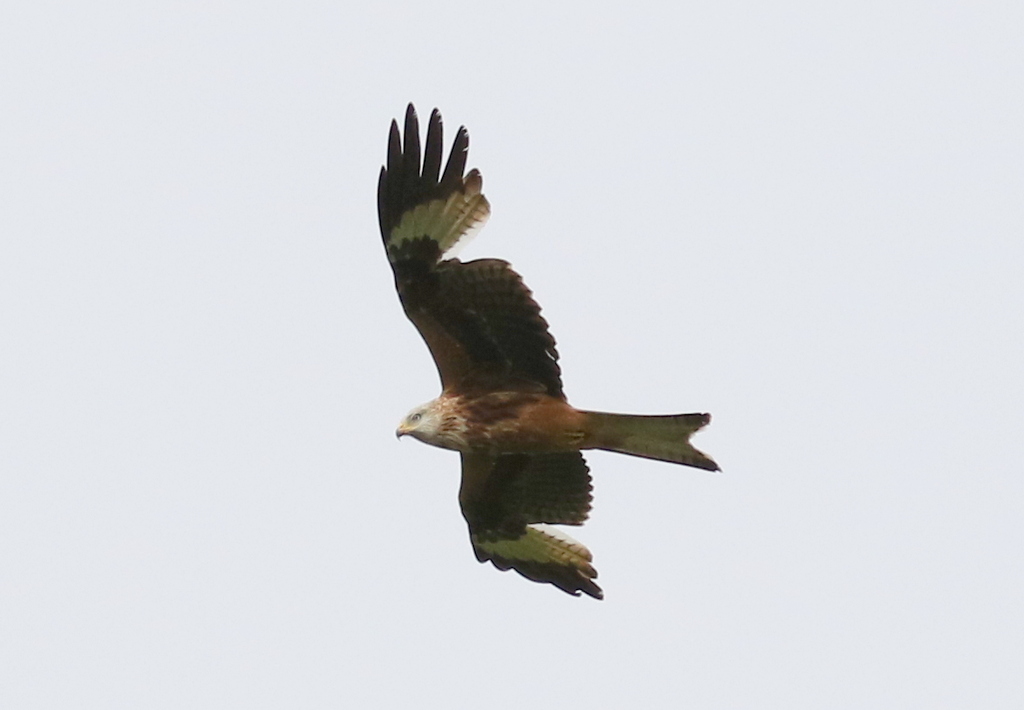
As we made our way west along the path on the inland side of the pines, it seemed rather quiet at first. However, we quickly started to hear a few warblers singing – first a Chiffchaff and a Blackcap, then our first Willow Warbler of the day. They were hard to see in the wind though today and the tits seemed to be keeping mostly to the pines too.
At Salts Hole, a couple of Tufted Ducks were diving out in the middle and a single drake Teal was lurking under one of the overhanging trees. Another Spoonbill circled up from the marshes beyond and flew off towards the trees out in the middle. A Redpoll flew over calling, but we couldn’t see it.
When we got to the gate just before Washington Hide, a Sedge Warbler was singing from somewhere in the reeds. We could see one of the wardens walking out across the marshes, doing a survey. Given the disturbance this would mean, we decided to walk straight on towards Joe Jordan Hide. A Lesser Whitethroat sang briefly from somewhere deep in the bushes just before the crosstracks and a Blackcap was more obliging, perching up nicely for us to look at it in the scope.
From up in the hide, we could see several Spoonbills down on the pool below. We got one of them in the scope and could see its yellow-tipped black bill, bushy nuchal crest and mustard wash on its breast, all singling it out as a breeding adult. We could see its spoon-shaped bill too.
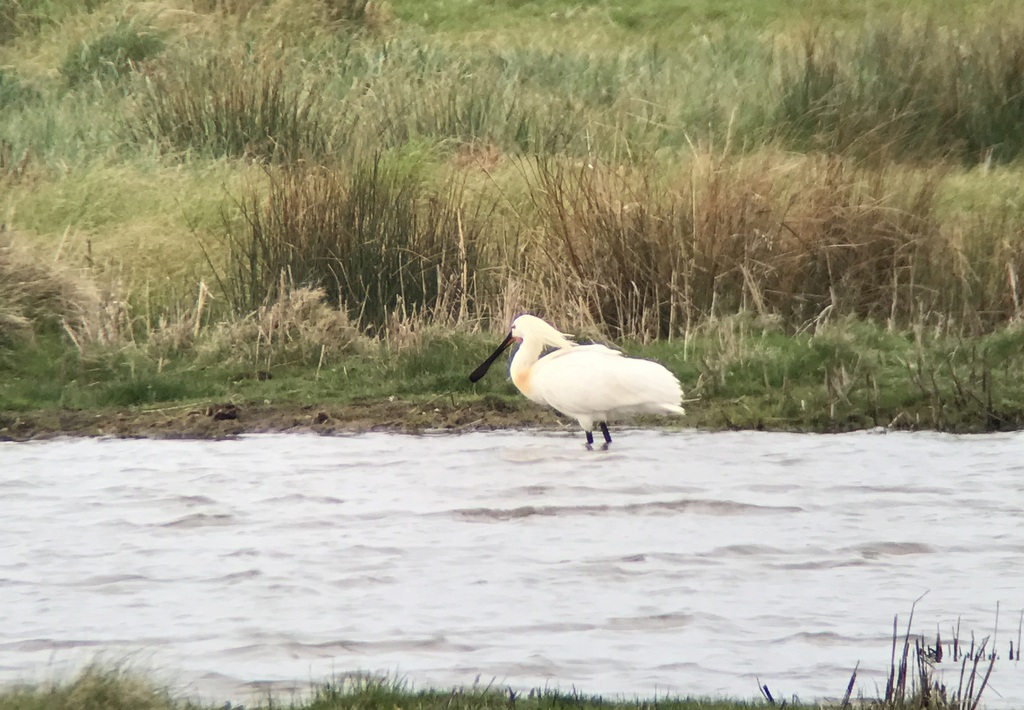
The Spoonbills were coming and going from the trees beyond. We saw a couple of Little Egrets flying in and out too, which is good to see after they were hit so badly by the cold weather over the winter. A Grey Heron dropped into the trees too, but there was no sign of any of the Great White Egrets from here this morning.
An Egyptian Goose was standing on the grass right in front of the hide and took off as another flew past, flashing its boldly marked black and white wings. There were plenty of Greylag Geese out on the grass too and, after searching through them carefully, we found a couple of Pink-footed Geese in with them. Looking at the two species through the scope, side by side, the Pink-footed Geese were noticeably smaller and darker headed, with a more delicate dark bill with a pink band. A Barnacle Goose, presumably a feral bird from the Park, was with another group of Greylags further over.
There were more Marsh Harriers out here and at one point we watched as a female grappled talons with first one and then quickly afterwards a second male. She didn’t seem attached to either and both looked like aggressive encounters. A Kestrel which dropped down to perch on the grassy bank below the hide. A Muntjac out in the middle of the grazing marshes seemed completely unperturbed by a pair of Greylags noisily hissing and honking at it.
After a while, we headed on towards the dunes. When we got to the gate at the end of the pines, we saw the warden again walking out across the middle of the marshes. A Great White Egret flew up briefly, but then dropped back down out of view. A small group of geese flushed from over towards the seawall and flew round towards us – six more Pink-footed Geese. Three of them had obvious damage to their wing feathers, presumably enough to make make the journey back to Iceland difficult.
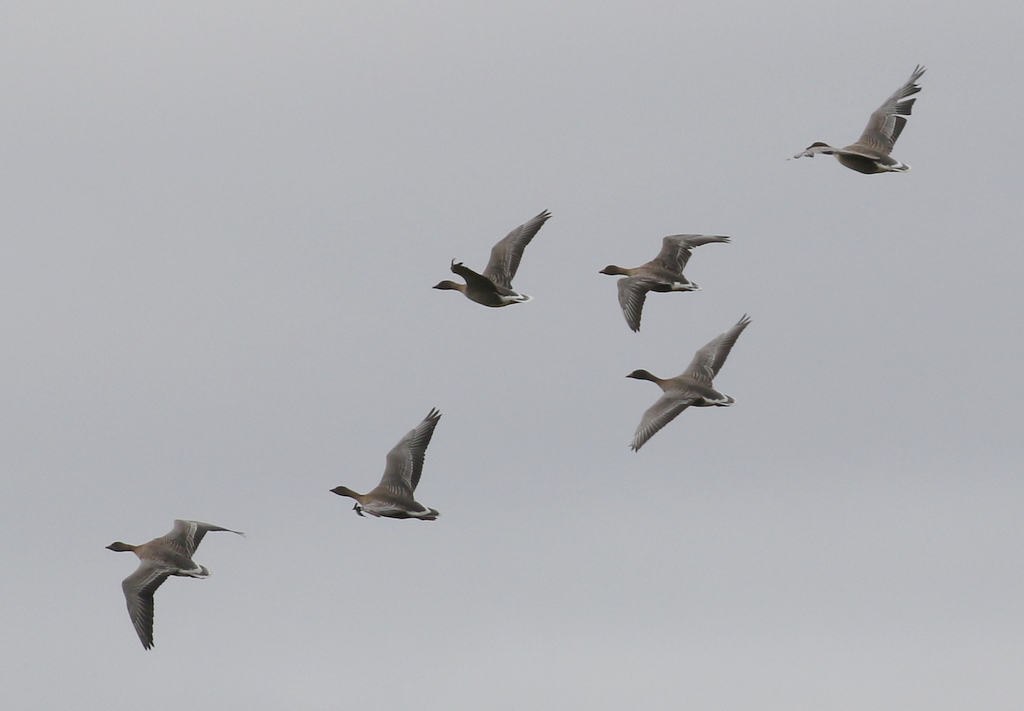
Out into the dunes, the bushes beyond the fence were very quiet today. There was no obvious sign of any new migrants and we couldn’t find any Ring Ouzels either here today. It was rather exposed and windy here though. We continued on a little further and noticed a black bird on a bramble on the top of the dunes ahead of us. Through the scope, we confirmed that it was a Ring Ouzel.

The Ring Ouzel was a female, with a rather dull crescent on its breast, lacking the bright white one of a male. We could see its silvery edged wings too. We managed to get a little bit closer to it, but it was very flighty and eventually headed off over the dunes.
There were a few Linnets and a Meadow Pipit or two in the dunes, but no obvious sign of large numbers of birds moving. Then we heard a whistling call and looked up to see a Whimbrel flying over. We could see it was distinctly smaller and more streamlined than a Curlew, with a shorter bill.
A flash of a white rump alerted us to a Wheatear flying away ahead of us. It dropped down the other side of a grassy ridge and by walking round on to some higher ground we were able to get a good look at it in the scope. It looked to be a male Greenland Wheatear, large and long-winged, richly-coloured below and with brown tones in the grey mantle.
The Wheatear was very flighty too and suddenly shot off over the dunes. We found the female Ring Ouzel again, in a sheltered area in the dunes, but it also flew off before we could look at it properly. Time was getting on and we had a long walk back to the car, so we decided this was as far as we could go today. We turned to head back.
We had a walk back through the middle of the dunes, hoping we might find a male Ring Ouzel lurking somewhere, but it was quiet here. A couple of Swallows flew over us and disappeared off west. Scanning the grazing marshes from the top of the dunes, just before we got back to the pines, we finally got a better look at a Great White Egret. One was feeding in a ditch out on the marshes and through the scope we could see its long, yellow, dagger-shaped bill.

The walk back was fairly uneventful until we got to the crosstracks. We thought it might be worth a look along the path which heads into the trees to the north, as it can be a little more sheltered in here. We had just stopped to watch a pair of Long-tailed Tits collecting feathers when another bird popped out onto the edge of one of the trees in front of us.
It was a small warbler, with a bright lemon yellow supercilium and breast, contrasting white belly and moss green upperparts – a Wood Warbler! This is a very scarce spring migrant here, but unfortunately it dropped back into the trees before everyone could get onto it and we lost sight of it. Despite searching, we couldn’t find it again – it had probably gone back into the pines out of the wind.
Eventually we had to give up and continue on our walk back. A Sedge Warbler singing from some brambles in the reeds just beyond Meals House was more obliging. We could see the blue sky approaching as we got back to Lady Anne’s Drive, but it was very windy here so we decided to head over to Titchwell for lunch. On the way, we spotted a Grey Wagtail on the driveway by Burnham Overy Watermill. We stopped for a second to watch it and could see it was collecting nest material.
As we walked over to the picnic area from the car park at Titchwell, we could hear Redpolls calling and we could just make out one high in the pines with the Goldfinches. Thankfully, they then flew out of the pines and into the alders above the picnic area and we could see there were four Mealy Redpolls.

With the sun out and in the shelter of the trees, it was nice sitting in the picnic area. Several butterflies appreciated the improvement in the weather too, with Brimstone and Peacock both flying past. A female Blackcap appeared on the edge of the sallows, closely followed by a male, which proceeded to sing and feed in front of us.
After lunch, we headed over to the Visitor Centre. There were a few Chaffinches and Greenfinches around the feeders, and we quickly found a Brambling in the trees just behind. We watched for a while and at least three different Bramblings came in to feed.
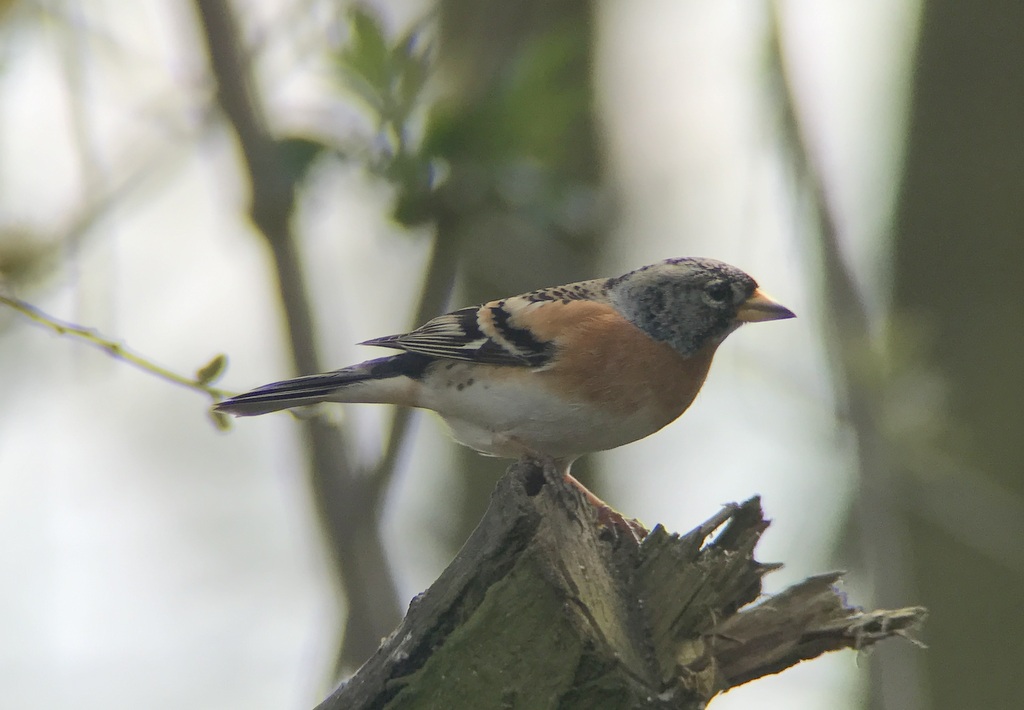
We made our way round to Patsy’s Reedbed first. There had been a few different birds here earlier this morning, but there was very little to see now. A couple of Swallows flew across over our heads and carried on west, as did a Siskin and a couple of Linnets – a trickle of migrants moving. We had a look in the paddocks, but there was just one Pied Wagtail in here today. We made our way back round via Meadow Trail.
It was very blustery once we got onto the main path and out of the trees. We stopped to look at Thornham grazing marsh, but it was hard to keep the scope still. We couldn’t see the Little Ringed Plover which had been here earlier. A single Grey Plover was on the Lavendar Marsh Pool. There were a few Common Pochard on the reedbed pool and a Sedge Warbler singing from somewhere deep in the brambles in the reeds.
Island Hide provided a very welcome shelter from the wind. The water level on the freshmarsh is much better for waders now, but the whole area is completely dominated by the gulls, mostly Black-headed Gulls. We had heard a few Mediterranean Gulls on the walk out, and seen their pure white wingtips as they flew overhead, but now we got a chance to see the two species side by side on the water.
A Common Tern was hiding on the back of one of the islands, behind a big group of Black-tailed Godwits. It was hard to see at first, until it was chased out into the open by a gull. This is the first Common Tern we have seen back here this year.

The number of ducks on here continue to decline, as birds head back to the continent for the breeding season. There were still a few Teal around the edges and a couple of pairs of Shoveler. The Brent Geese kept flying in from the saltmarsh whenever they got spooked, sometimes staying for a bathe and a preen. They should be heading off back to Russia too soon.
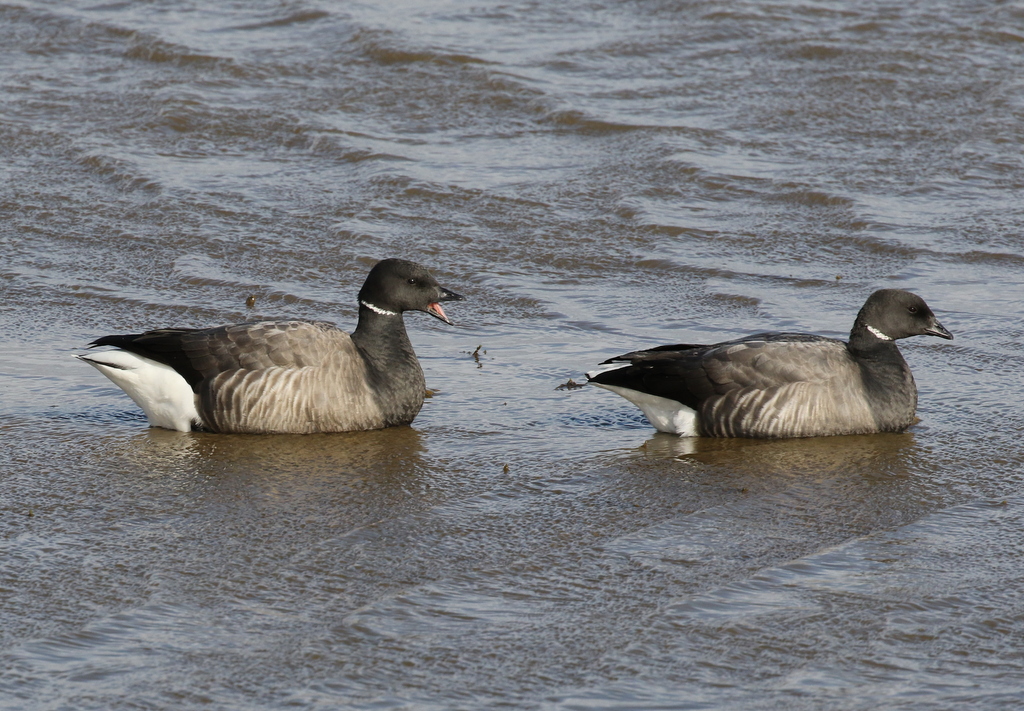
There are quite a few Avocets on the freshmarsh now, busy feeding in the deeper water. A couple of little groups of Black-tailed Godwits were mostly sleeping on the islands or in the shallows. Some of the Black-tailed Godwits are moulting now, and starting to get the bright rusty orange head and breast of breeding plumage. There were a couple of Ruffs too – a paler male and one more heavily speckled with black.

Scanning the bank over the far side, we picked up a small group of 5-6 hirundines flying towards the reserve. They were Sand Martins and they gradually worked their way across the Freshmarsh and away to the west, the first we have seen this year.
We decided to brave the wind again and head out to the beach. There was not much to see on Volunteer Marsh until we got to the channel at the far side. Here there were a couple more Black-tailed Godwits, several Redshanks and one or two Curlew. Down in the muddy channel in the middle we picked up a small group of Knot. The Tidal Pools are not tidal any more and full of water now – storms over the winter blocked up the drainage channel – so there was nothing to see here again.
The sand on the beach was being whipped up by the wind. There were lots of Oystercatchers and a couple of Curlew on the mussel beds at the bottom of the beach, but not much else. All the other waders were scattered out on the sand towards Thornham Point. They were distant, but we could make out Bar-tailed Godwits, Dunlin and Sanderling all to add to the day’s list.
Scanning the sea produced several Great Crested Grebes and a few Common Scoter lingering offshore. But it was not especially pleasant out on the beach today, so we decided to start making our way back.
As we passed the Volunteer Marsh, a female Red-crested Pochard flew in from the direction of the Tidal Pools and dropped down towards the Freshmarsh. There was still no sign of the Little Ringed Plover out in the open on the Thornham grazing marsh ‘pool’ but it must have been lurking somewhere out of sight because it flew up just as we had passed and headed off back towards the Freshmarsh. On the way to the car park, we stopped to listen to a Brambling singing – though it sounds more like a wheeze than a song!
When we got back to the car, we still had time for one last stop on our way home. There had been a Pied Flycatcher in Burnham Thorpe village all afternoon, so we took a quick detour inland. There were only a couple of other people looking by the time we arrived, but we found it fairly quickly in the trees at the end of the small park.

We watched the Pied Flycatcher for a bit, as it dropped down into the hedge at the back and then made several sallies out after insects. It made its way along the other side of the hedge past us, stopping on several fence posts on the way. You could just see it each time, if you found the right angle to line up with a gap through the hedge.
It was a great way to end the day, watching the Pied Flycatcher in the afternoon sunshine. Eventually we had to tear ourselves away and head for home.
















